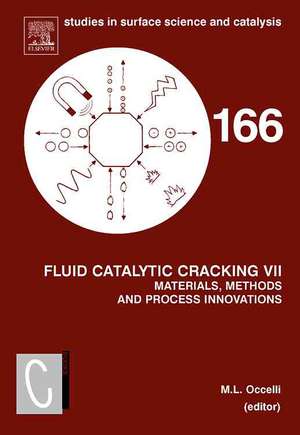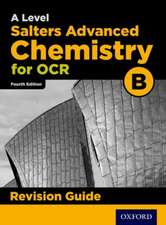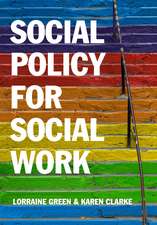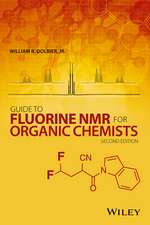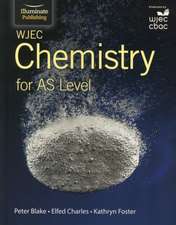Fluid Catalytic Cracking VII:: Materials, Methods and Process Innovations: Studies in Surface Science and Catalysis, cartea 166
Mario L. Occellien Limba Engleză Hardback – 19 iul 2007
* Presents findings from the tri-annual international symposium on fluid cracking catalysts (FCC) technology, sponsored by the Petroleum Division of the American Chemical Society (ACS) * Two contributions describe the use of predictive methods to understand FCC aging and deactivation* Personal overviews by the authors of the development of SOx and combustion promoters technology
Din seria Studies in Surface Science and Catalysis
- 9%
 Preț: 885.10 lei
Preț: 885.10 lei - 27%
 Preț: 1304.37 lei
Preț: 1304.37 lei - 27%
 Preț: 1302.25 lei
Preț: 1302.25 lei - 27%
 Preț: 1302.53 lei
Preț: 1302.53 lei - 27%
 Preț: 1297.21 lei
Preț: 1297.21 lei - 27%
 Preț: 1290.46 lei
Preț: 1290.46 lei - 27%
 Preț: 1303.81 lei
Preț: 1303.81 lei - 27%
 Preț: 1296.65 lei
Preț: 1296.65 lei - 27%
 Preț: 1294.66 lei
Preț: 1294.66 lei - 27%
 Preț: 1305.91 lei
Preț: 1305.91 lei - 27%
 Preț: 1305.08 lei
Preț: 1305.08 lei - 27%
 Preț: 1433.80 lei
Preț: 1433.80 lei - 27%
 Preț: 1301.30 lei
Preț: 1301.30 lei - 27%
 Preț: 1317.26 lei
Preț: 1317.26 lei - 27%
 Preț: 1191.02 lei
Preț: 1191.02 lei - 27%
 Preț: 1185.10 lei
Preț: 1185.10 lei - 27%
 Preț: 1185.10 lei
Preț: 1185.10 lei - 27%
 Preț: 1309.57 lei
Preț: 1309.57 lei - 9%
 Preț: 1778.96 lei
Preț: 1778.96 lei - 23%
 Preț: 1200.06 lei
Preț: 1200.06 lei - 39%
 Preț: 1079.57 lei
Preț: 1079.57 lei - 28%
 Preț: 1055.25 lei
Preț: 1055.25 lei - 14%
 Preț: 2164.67 lei
Preț: 2164.67 lei - 9%
 Preț: 1161.45 lei
Preț: 1161.45 lei
Preț: 1186.09 lei
Preț vechi: 1624.78 lei
-27% Nou
Puncte Express: 1779
Preț estimativ în valută:
226.98€ • 246.47$ • 190.67£
226.98€ • 246.47$ • 190.67£
Carte tipărită la comandă
Livrare economică 22 aprilie-06 mai
Preluare comenzi: 021 569.72.76
Specificații
ISBN-13: 9780444530608
ISBN-10: 0444530606
Pagini: 356
Dimensiuni: 165 x 240 x 19 mm
Greutate: 0.78 kg
Editura: ELSEVIER SCIENCE
Seria Studies in Surface Science and Catalysis
ISBN-10: 0444530606
Pagini: 356
Dimensiuni: 165 x 240 x 19 mm
Greutate: 0.78 kg
Editura: ELSEVIER SCIENCE
Seria Studies in Surface Science and Catalysis
Public țintă
Students, researchers and practitioners in the fields of catalysis, chemical engineersCuprins
1. Development of High-Severity FCC Process: An Overview (Yuchiro Fujiyama).
2. Discrepancies in FCC Catalyst Evaluation of Atmospheric Residues (Sven-Ingvar Andersson).
3. Novel Coke Shift Matrix Technique to Enhance the Activity of the Secondary Reaction Zone in MIP-CGP Process (Jun Long et al.).
4. Exploring FCC flexibility to produce mid-distillate and petrochemicals (W. Richard Gilbert et al.).
5. Improving LCO yield and quality in FCC units: Cracking pathways analysis (A. Corma, L. Sauvanaud).
6. FCC Catalyst for the Process of Increasing Cleaner Gasoline and Propylene Production (Jun Long et al.).
7. Towards a new generation of NOx additives (D.M Stockwell.
8. Pt-based CO Combustion Promoters: Past and Present (A.W. Chester).
9. FCC regenerator simulation by Lambda Sweep testing (D.M Stockwell).
10. Laboratory simulation of FCC equilibrium catalyst using a deactivation mathematical model
(L.O. Almanza).
11. Intra-particle mass transfer and contact time effects in FCC (D.M Stockwell).
12. Equilibrium FCC catalyst performance simulation based on mixtures of hydrothermal dactivated samples (L. Antonio et al.).
13. NMR studies of FCC feeds, catalysts and Coke
(B. Behera et al.).
14. Impact of iron contaminated species on FCC catalyst (Yuxia Zhu et al.).
15. Catalytic cracking to liquid (BTL) fuels with novel cracking catalysts (A.A. Lappas, I.A. Vasalos).
16. Catalytic Cracking: The future of an evolving process (P. O'Connor).
17. Fundamental of SOx reduction technology in fluid catalytic cracking units (FCCU) (L. Magnabosco).
18. Evaluation of commercial SOx agents effectiveness via a fundamental mathematical model
(L. Magnabosco).
2. Discrepancies in FCC Catalyst Evaluation of Atmospheric Residues (Sven-Ingvar Andersson).
3. Novel Coke Shift Matrix Technique to Enhance the Activity of the Secondary Reaction Zone in MIP-CGP Process (Jun Long et al.).
4. Exploring FCC flexibility to produce mid-distillate and petrochemicals (W. Richard Gilbert et al.).
5. Improving LCO yield and quality in FCC units: Cracking pathways analysis (A. Corma, L. Sauvanaud).
6. FCC Catalyst for the Process of Increasing Cleaner Gasoline and Propylene Production (Jun Long et al.).
7. Towards a new generation of NOx additives (D.M Stockwell.
8. Pt-based CO Combustion Promoters: Past and Present (A.W. Chester).
9. FCC regenerator simulation by Lambda Sweep testing (D.M Stockwell).
10. Laboratory simulation of FCC equilibrium catalyst using a deactivation mathematical model
(L.O. Almanza).
11. Intra-particle mass transfer and contact time effects in FCC (D.M Stockwell).
12. Equilibrium FCC catalyst performance simulation based on mixtures of hydrothermal dactivated samples (L. Antonio et al.).
13. NMR studies of FCC feeds, catalysts and Coke
(B. Behera et al.).
14. Impact of iron contaminated species on FCC catalyst (Yuxia Zhu et al.).
15. Catalytic cracking to liquid (BTL) fuels with novel cracking catalysts (A.A. Lappas, I.A. Vasalos).
16. Catalytic Cracking: The future of an evolving process (P. O'Connor).
17. Fundamental of SOx reduction technology in fluid catalytic cracking units (FCCU) (L. Magnabosco).
18. Evaluation of commercial SOx agents effectiveness via a fundamental mathematical model
(L. Magnabosco).
